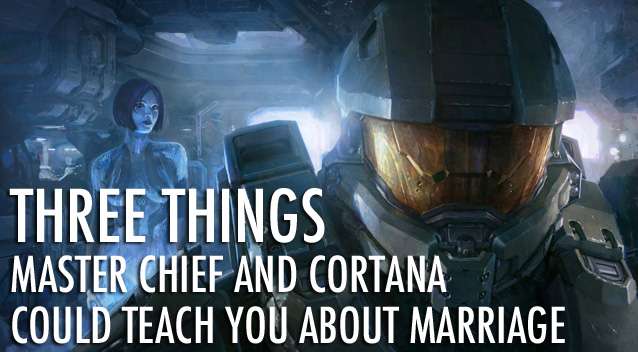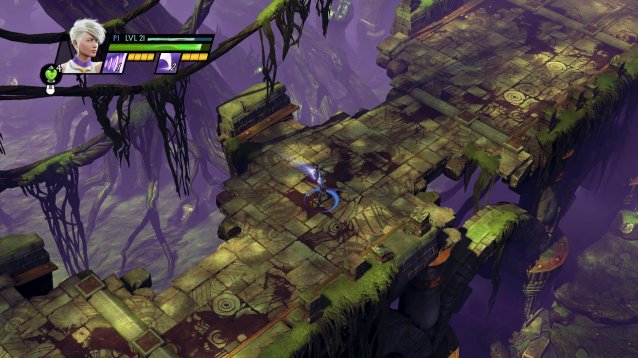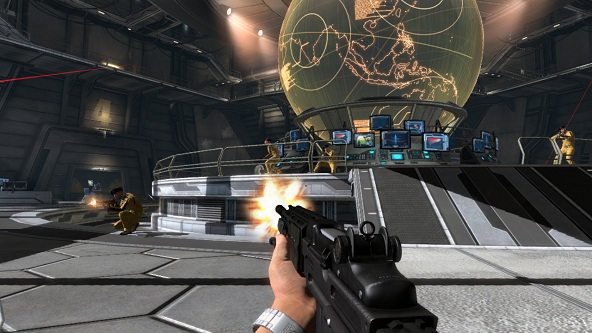

Going back to Gears of War ten years after its original release is an exercise in myth-busting. Rightly iconic, but long since muddied in the public memory by a string of differently focused sequels, not to mention the decade-long cover-shooter boom it inspired, Gears is a game defined now as much by perception and periphery as by the concrete matter of what it actually is. It’s dude-bro ground zero to some. It’s a big dumb gun game to others. In truth, it’s neither of those things. In truth, it’s still one of the cleverest and most resonant shooters of the last decade.
At first, you might not realise that. The Ultimate Edition’s new difficulty settings – trading the original Casual, Hardcore and (unlockable) Insane for Easy, Normal, Hardcore and (ready to go) Insane – rather betray the game’s quality, leading those looking for the real Gears experience a little way down the wrong alley. Normal, you see, is pitched rather below the shooting model’s sweet-spot, forcing stringent use of cover by way of swift deaths for the unwary, but reducing the once-stoic bullet-sponges of the Locust horde to flimsy three-shot wonders. It’s a fun, slick, kinetic experience, but not one that particularly stands out from the raft of waist-high wars that have come since the game’s original release. Crank things up to Hardcore though, and you’ll suddenly realise what a unique and important game Gears of War still is.
The Ultimate Edition comes with a full suite of multiplayer modes, including new Team Deathmatch, King of the Hill, and 2v2 Gnasher Execution set-ups, alongside a raft of customisation options and all the maps, including the original DLC offering. It can be played online, in splitscreen, or over LAN, but it's a bit too soon to properly appraise things without access to live, post-release conditions. If any major problems arise, we'll keep you posted and update this review to reflect them.
The immediate ferocity alone is enough to blow a decade’s worth a shooter-fatigued cobwebs out of your ears. I use the word ‘resonant’ above very deliberately, because the concept of resonance applies throughout all areas of Gears’ design, but most immediately and obviously you’ll notice it as soon as you pull a trigger. Few games have tactile, reverberating gunfeel like Gears of War. Firing any of its eclectic, but insightfully controlled, roster of weapons genuinely feels – through a masterful combination of character weight, audio design, and visual pay-off – like operating a piece of heavy machinery engineered to fire pieces of metal through something’s flesh. It’s rare that games get that tactility right. Fighting in Gears has a staggering sense of presence and place. It makes every action resonate.
The average Locust grunt can take a full clip of Lancer ammo and five to ten seconds of sustained fire to down, seconds you’ll rarely have the opportunity to unleash in one uninterrupted salvo. In Gears’ heavier firefights you’ll never be more than a few seconds of exposure from death, meaning that your every action must be staunchly appraised and reappraised on the fly to squeeze the maximum effectiveness out of every opportunity you can make or steal. It’s a tremendously exhilarating and deceptively cerebral system, built around the constantly engaging – yes – resonance between cause, effect, momentum and defence, and one which absolutely sings when amplified by Gears’ thoughtful weapon set.
Every gun, from the standard-issue Lancer rifle, to the short-range devastation of the Gnasher shotgun, to the slow, high-risk, long-range power of the Longshot sniper and Torque Bow, has immense situational advantages and failings, the nuances of which you’ll still be learning and mastering long into the game. It’s a precisely balanced and smartly stripped-down weapon-set, especially by comparison to Gears 3’s more extravagant, less focused line-up, and one which the game’s skirmish design rings every possible ounce of versatility from.
You’ll rarely run into two similar stand-offs in a row, Gears’ tight, meticulously designed battlegrounds pitched to reconfigure and recontextualise its robust, core combat in a different way each time the action kicks off. Some areas reward carefully balanced aggression in focused pushes. Others deal with your ability to control crowds spilling from multiple sources, or force you to think fast on the back foot, as aggressive shotgunners press down on your position, backed by longer-range riflemen or heavies.
Gears’ more overtly themed battles are even better, sometimes forcing you to choose – and create – safe routes through lethal, Krill-infested darkness while simultaneously dealing with an uncompromisingly claustrophobic battle, or perhaps providing movable cover with which to shift your array of options and firing lines as the fight plays out. It’s the best possible tribute the Gears of War’s design that ten years later, it isn’t a game of fondly remembered, stand-out set-pieces held together with long-forgotten connective tissue, but rather a game in which almost every battle comes flooding back the instant it starts, the majority feeling like carefully crafted ‘special’ moments in their own right. Resonance. A decade on, still so much resonance.
That’s the body and soul of Gears then, but what of its new, 2015 face? Visually, it’s a hell of an upgrade, bringing the game well up to the standard of later releases like Gears 3 and Judgment. Admittedly, you might not notice at first, if you haven’t played the game since its original release, but that’s just the nature of nostalgia. The Ultimate Edition effectively delivers a Gears of War that looks like the game does in your rose-tinted memories, a vast, objective upgrade from its original iteration, but one that stays true to the desperate, stark atmosphere that made the original overall experience such an affecting tonal reflection of its gameplay.




 Smoke Detector Battle: Roost Smart Battery Vs Nest Protect
Smoke Detector Battle: Roost Smart Battery Vs Nest Protect Dark Souls 2 HD: PS4 vs PS3 Graphics Gameplay Comparison
Dark Souls 2 HD: PS4 vs PS3 Graphics Gameplay Comparison Change NAT type PS4 / Xbox One - open router ports and configure firewall
Change NAT type PS4 / Xbox One - open router ports and configure firewall Destiny: TTK Guide - How to Beat the King's Fall Raid
Destiny: TTK Guide - How to Beat the King's Fall Raid 007 Legends Walkthrough
007 Legends Walkthrough